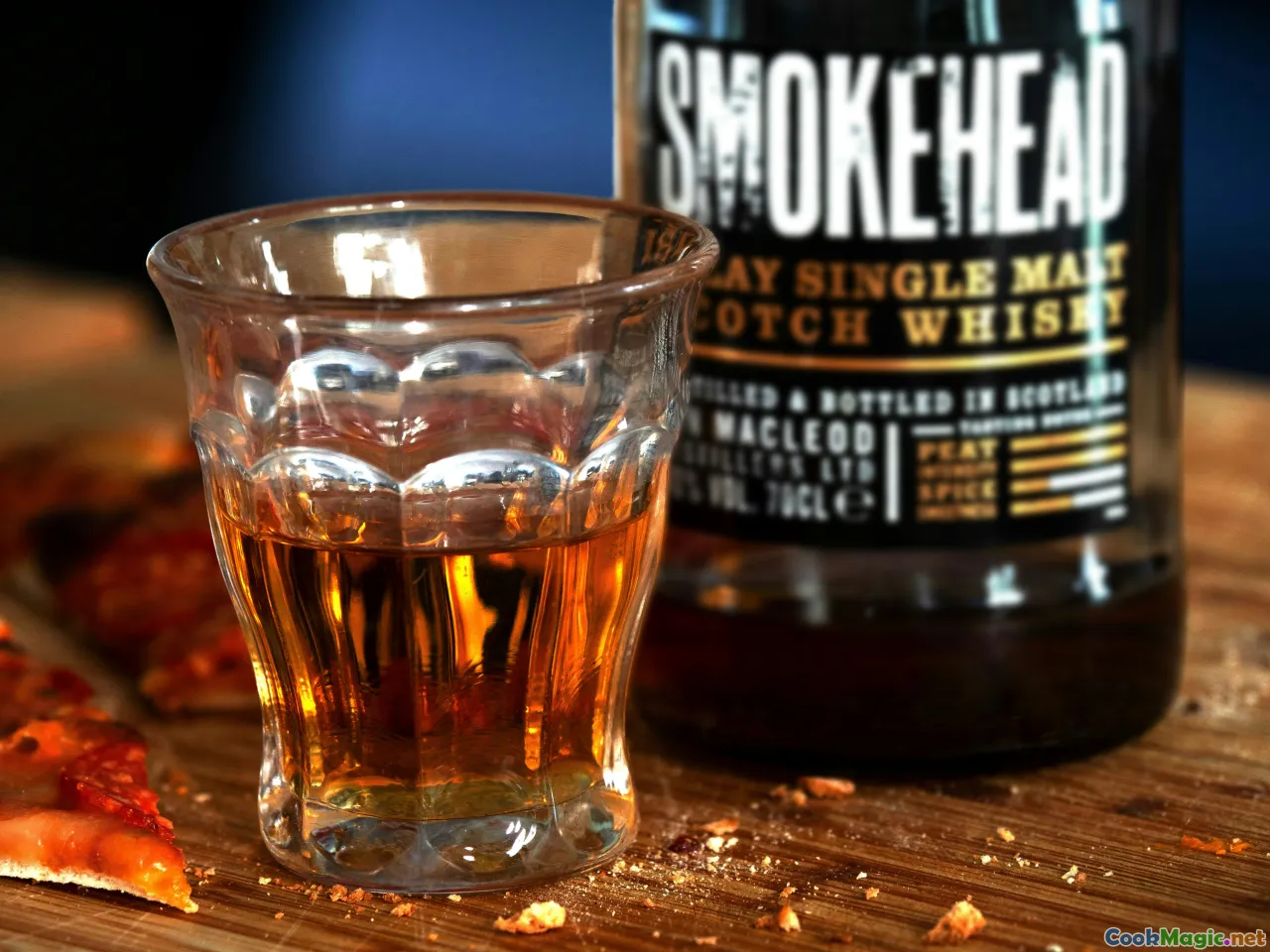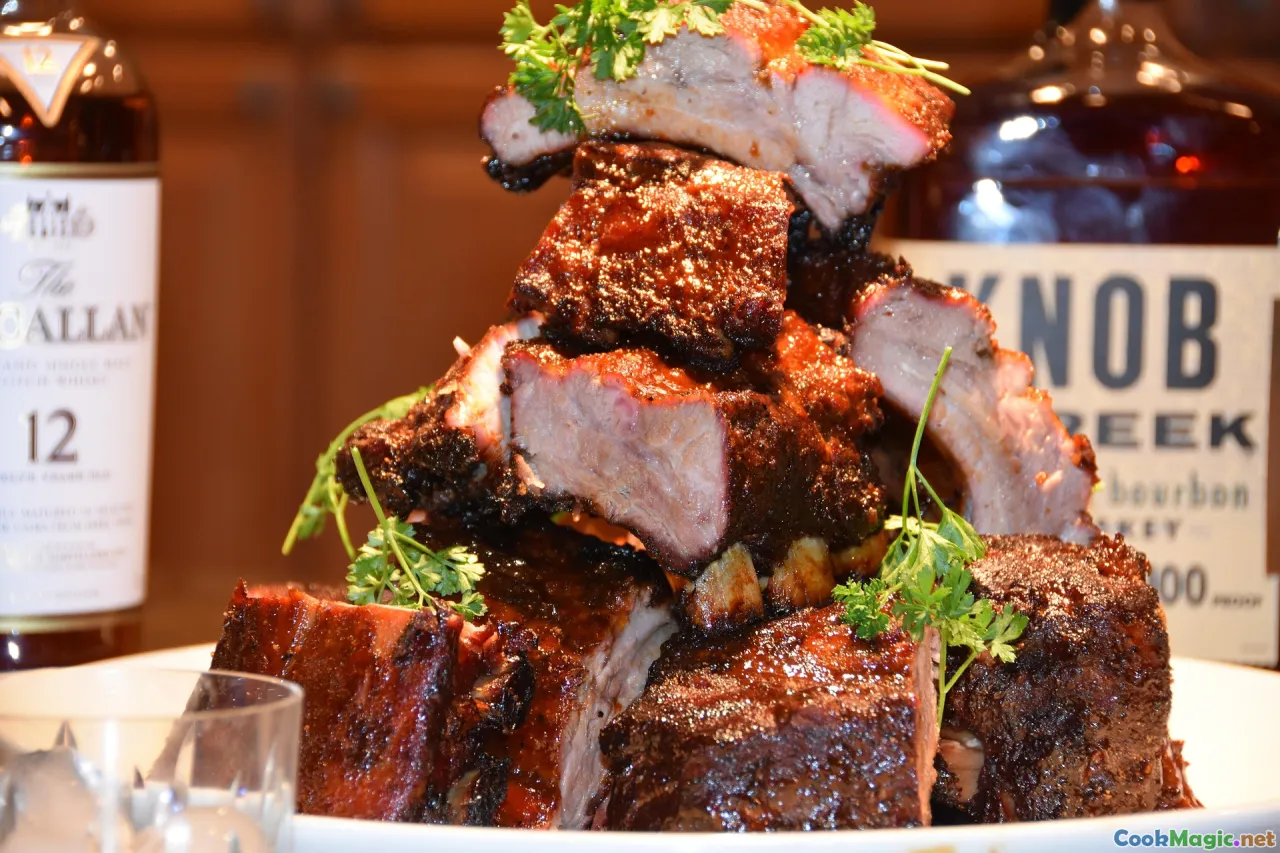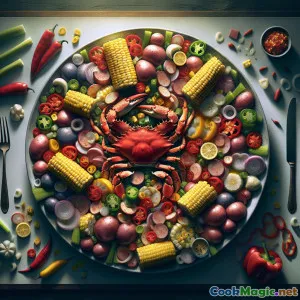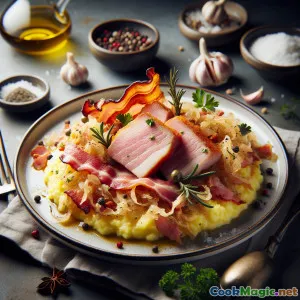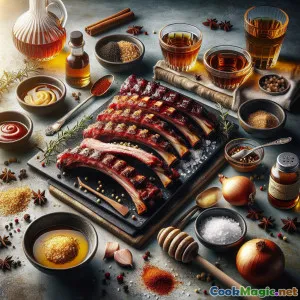
ضلوع أبالاشيا المدخنة مع صلصة بوربون
(Smoky Appalachian Maple Ribs with Bourbon Glaze)
(0 المراجعات)المكونات
-
2 racks ضلوع الخنزير
(About 2.5–3 lb each; baby backs also work)
-
2 tbsp خردل أصفر
(Binder for the rub; does not affect flavor)
-
2 tbsp ملح كوشير
(Adjust to taste and rib size)
-
3 tbsp سكر بني
(For the dry rub sweetness and bark)
-
2 tbsp بابريكا مدخنة
(Adds color and smoky depth)
-
1 tbsp فلفل أسود مطحون طازجًا
(Coarse grind preferred)
-
2 tsp بودرة الخردل
(Sharpens the rub)
-
2 tsp بودرة الثوم
(Savors the bark)
-
2 tsp بودرة البصل
(Balances sweetness and smoke)
-
0.5 tsp فلفل كايين
(For a gentle Appalachian heat)
-
120 ml خل التفاح
(For spritzing and tang)
-
120 ml عصير تفاح
(Spritz mix to keep ribs moist)
-
180 ml شراب القيقب النقي (عنبر الدرجة A)
(Primary glaze sweetness; use real maple)
-
60 ml بوربون
(Adds vanilla-caramel notes to glaze)
-
3 tbsp كاتشب
(Body and tang for the glaze)
-
1 tbsp خردل ديجون
(Emulsifies glaze and adds bite)
-
2 tbsp زبدة غير مملحة
(For wrapping and richness)
-
2 tbsp عسل
(Optional extra shine in wrap)
-
240 ml ماء
(For smoker water pan humidity)
-
4 pieces قطع خشب تفاح أو هيكوري
(Use applewood for gentler smoke; hickory for bolder)
-
2 sheets ورق ألمنيوم مقوى أو ورق جزار
(For wrapping during cook)
-
1 tsp فلفل أسود خشن (للتشطيب)
(Crack over sliced ribs before serving)
-
1 tsp ملح رقائقي (لللمسة النهائية)
(Optional finishing pop)
(About 2.5–3 lb each; baby backs also work)
(Binder for the rub; does not affect flavor)
(Adjust to taste and rib size)
(For the dry rub sweetness and bark)
(Adds color and smoky depth)
(Coarse grind preferred)
(Sharpens the rub)
(Savors the bark)
(Balances sweetness and smoke)
(For a gentle Appalachian heat)
(For spritzing and tang)
(Spritz mix to keep ribs moist)
(Primary glaze sweetness; use real maple)
(Adds vanilla-caramel notes to glaze)
(Body and tang for the glaze)
(Emulsifies glaze and adds bite)
(For wrapping and richness)
(Optional extra shine in wrap)
(For smoker water pan humidity)
(Use applewood for gentler smoke; hickory for bolder)
(For wrapping during cook)
(Crack over sliced ribs before serving)
(Optional finishing pop)
التغذية
- الحصص: 6
- حجم الحصة: 3–4 bones (350g)
- Calories: 720 kcal
- Carbohydrates: 0 g
- Protein: 45 g
- Fat: 40 g
- Fiber: 1 g
- Sugar: 28 g
- Sodium: 980 mg
- Cholesterol: 145 mg
- Calcium: 60 mg
- Iron: 2.3 mg
التعليمات
-
1 - Trim and prep ribs:
Pat ribs dry. Remove silver skin membrane from the bone side by slipping a butter knife under an edge and pulling with a paper towel for grip. Trim any dangling fat.
-
2 - Mix the dry rub:
Combine kosher salt, brown sugar, smoked paprika, black pepper, mustard powder, garlic powder, onion powder, and cayenne. Stir until uniform.
-
3 - Bind and season:
Rub ribs lightly with yellow mustard as a binder. Coat both sides generously with the dry rub, pressing to adhere. Let sit while the smoker heats.
-
4 - Preheat smoker:
Heat smoker to 275°F (135°C). Add a water pan with water. Add wood chunks (applewood or hickory) for clean, thin blue smoke.
-
5 - Smoke phase one:
Place ribs meat-side up. Smoke 2 hours, spritzing every 45–60 minutes with a 1:1 mix of apple juice and cider vinegar to keep the bark moist.
-
6 - Wrap and tenderize:
Lay ribs on foil or paper. Dot with butter and honey (optional). Wrap tightly and return to smoker, meat-side down, for 60–90 minutes until bones start to peek.
-
7 - Make maple-bourbon glaze:
Simmer maple syrup, bourbon, ketchup, and Dijon in a small saucepan for 5–7 minutes until glossy and slightly thick. Keep warm.
-
8 - Set the glaze:
Unwrap ribs, flip meat-side up. Brush with glaze. Smoke unwrapped 15–25 minutes to set and tack up, repeating a light brush if desired.
-
9 - Rest the ribs:
Remove from smoker when probe-tender (195–203°F internal). Tent loosely with foil and rest 10–15 minutes to reabsorb juices.
-
10 - Slice and Serve:
Brush a final kiss of glaze, crack coarse pepper, and slice between bones. Finish with a pinch of flaky salt if desired.
Pat ribs dry. Remove silver skin membrane from the bone side by slipping a butter knife under an edge and pulling with a paper towel for grip. Trim any dangling fat.
Combine kosher salt, brown sugar, smoked paprika, black pepper, mustard powder, garlic powder, onion powder, and cayenne. Stir until uniform.
Rub ribs lightly with yellow mustard as a binder. Coat both sides generously with the dry rub, pressing to adhere. Let sit while the smoker heats.
Heat smoker to 275°F (135°C). Add a water pan with water. Add wood chunks (applewood or hickory) for clean, thin blue smoke.
Place ribs meat-side up. Smoke 2 hours, spritzing every 45–60 minutes with a 1:1 mix of apple juice and cider vinegar to keep the bark moist.
Lay ribs on foil or paper. Dot with butter and honey (optional). Wrap tightly and return to smoker, meat-side down, for 60–90 minutes until bones start to peek.
Simmer maple syrup, bourbon, ketchup, and Dijon in a small saucepan for 5–7 minutes until glossy and slightly thick. Keep warm.
Unwrap ribs, flip meat-side up. Brush with glaze. Smoke unwrapped 15–25 minutes to set and tack up, repeating a light brush if desired.
Remove from smoker when probe-tender (195–203°F internal). Tent loosely with foil and rest 10–15 minutes to reabsorb juices.
Brush a final kiss of glaze, crack coarse pepper, and slice between bones. Finish with a pinch of flaky salt if desired.
المزيد عن : ضلوع أبالاشيا المدخنة مع صلصة بوربون
Why These Ribs Work
Smoky Appalachian Maple Ribs celebrate the mountain tradition of slow-cooked pork and woodsmoke paired with the region’s liquid gold: maple syrup. This recipe layers flavor in stages—seasoned bark, gentle smoke, a steam-tenderizing wrap, and a glossy maple-bourbon finish—so every bite is tender, sticky, and deeply aromatic. Applewood gives soft, orchard sweetness; hickory brings bolder campfire punch. At 275°F (135°C), the ribs render enough fat to stay juicy without sacrificing bark.
Flavor Blueprint
- Rub: A balanced blend of salt, brown sugar, paprika, garlic, onion, and mustard powder builds color and savory-sweet depth. A whisper of cayenne nods to Appalachian heat without overpowering the maple.
- Spritz: Apple juice and cider vinegar add tart brightness, helping smoke adhere and the bark set without drying.
- Glaze: Real maple syrup reduced with bourbon, ketchup, and Dijon creates a lacquer that clings to the ribs, caramelizing into a glassy, lip-smacking finish.
Technique Tips
- Clean smoke matters: Aim for thin blue smoke, not billowing white. White smoke can turn bitter.
- Binder wisdom: Mustard’s role is purely functional—it helps the rub adhere, and its sharpness cooks off.
- The wrap: Foil traps steam, accelerating tenderness. For a firmer bark, use unwaxed butcher paper; it breathes a bit more.
- Tenderness test: Rather than chasing a number, probe between bones. When the probe slides in like warm butter and bones peek 1/4–1/2 inch, you’re there.
- Glaze timing: Apply glaze in the last 15–25 minutes so sugars set without burning. Multiple thin coats beat one thick layer.
Make-Ahead and Variations
- Prep ahead: Mix rub up to a month in advance; store airtight. Ribs can be seasoned the night before; wrap and refrigerate.
- Bourbon-free: Replace bourbon with apple cider or a splash of strong black tea for tannic complexity.
- Heat level: Swap cayenne for chipotle powder for smoky heat, or omit for family-friendly ribs.
- Wood swap: Applewood for delicate sweetness; cherry for color and fruit; hickory for traditional backbone. Avoid mesquite—it can overwhelm maple’s nuance.
Serving Ideas
These ribs shine with skillet cornbread, braised greens, or a crunchy slaw dressed in cider vinegar. A side of beans cooked with a strip of bacon echoes smokehouse flavors. For drinks, reach for a dry cider, a malty amber ale, or sweet tea with lemon.
Troubleshooting
- Bark too soft after wrapping: Unwrap and extend the final, unwrapped phase to re-set bark; avoid brushing on too much glaze too early.
- Too sweet: Increase cider vinegar in the spritz, or finish with cracked black pepper and a squeeze of lemon for brightness.
- Dry ribs: Lower your pit temperature slightly and spritz earlier. Ensure a water pan is in place and the membrane was fully removed.
History & Cultural Notes
Appalachia’s culinary backbone is resourceful, place-driven cooking—smokehouses for preservation; orchards and cane for sweeteners; and communal gatherings built around pit-cooked pork. While Vermont and Canada are famed for maple, maple sugaring has a deep foothold along the Appalachian range, where sap runs in late winter and early spring. Early settlers and Indigenous practices alike influenced this sweet tradition. Pairing smoke-softened pork with maple’s woodsy caramel notes is a natural marriage, especially when kissed with bourbon, another regional icon with vanilla, oak, and toffee undertones.
What Makes This Recipe Unique
- Layered Appalachian cues: applewood smoke, cider tang, and real maple.
- Moderate pit temperature (275°F/135°C) for dependable rendering and a forgiving timeline.
- Glaze that balances sweet, tang, and spice, engineered to cling without burning.
- Flexibility: bourbon optional, wood choice adaptable, and wrapping medium customized to your bark preference.
Chef’s Notes
For consistent results, buy similarly sized racks so they finish together. Keep your pit lid closed—heat and smoke loss extends cook times. Finally, rest the ribs: that brief pause relaxes muscle fibers, keeping slices juicy and glistening. When you plate, add one last thin brush of warm glaze and a snap of coarse pepper—the aroma alone will draw a crowd, the true spirit of Appalachian hospitality.


